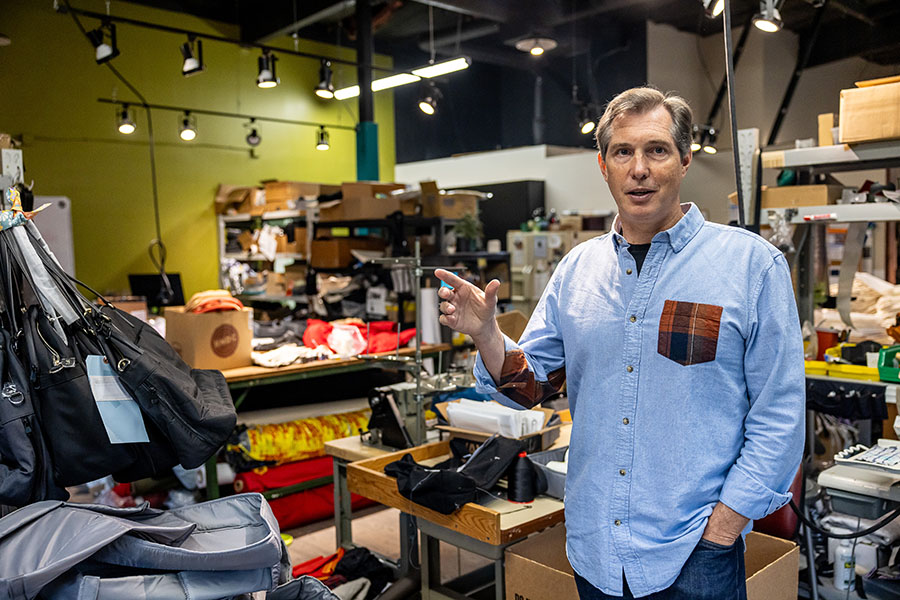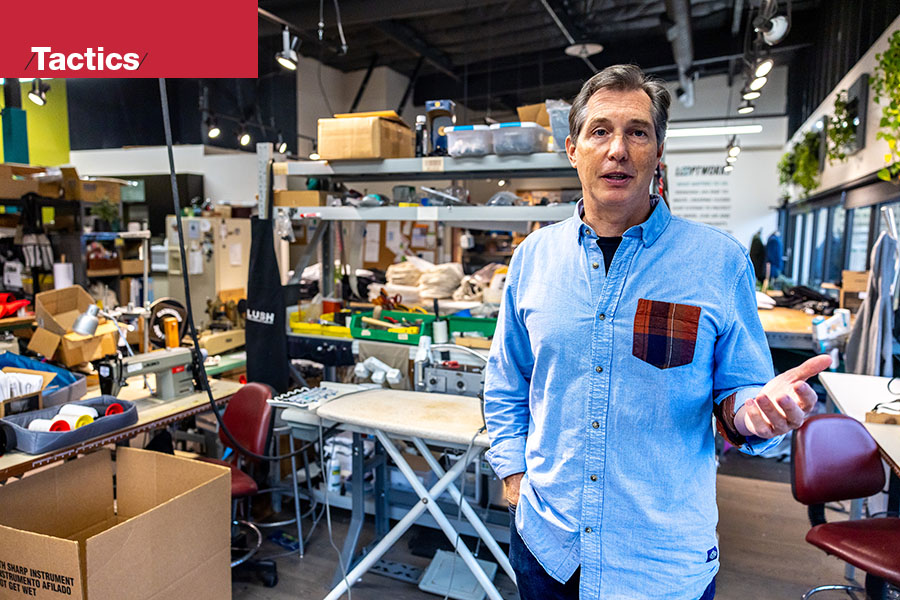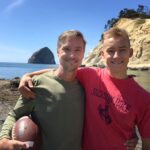The founder and CEO of Looptworks has been working to find a way to “turn a T-shirt back into a T-shirt” since 2009. A Gresham facility opening this month makes it a reality.
When Scott Hamlin started working in the outdoor-apparel industry in 2000, he found an industry that seemed at odds with his values.
A native Oregonian who grew up rock climbing and surfing, Hamlin studied journalism and ran track in college. He started working in the apparel industry in 2000 and worked for adidas, Jockey and Royal Robbins before founding Looptworks in 2009. He’d found that the apparel industry was “antiquated and disjointed, with supply chains all over the world” and a “tremendous amount of waste.” It wasn’t just that the garments themselves — or the excess fabric — ended up being landfilled after production. It was also the resources that went into creating the products: the water, the carbon emissions.
At first Looptworks partnered with apparel manufacturers to upcycle — that is, to recycle a product in a way that makes it more valuable — waste textiles into new materials like backpacks or wallets. Those were at first sold as direct-to-consumer products on its website (though now Looptworks only sells through third-party vendors). Its partners have included Southwest Airlines — which provided 43 acres’ worth of leather from its old seats after reupholstering its entire fleet with lighter upholstery — as well as Patagonia and the Portland Trail Blazers.
Since then Looptworks’ model has evolved to include downcycling — turning waste textiles into materials like fiber insulation for homes. But from the beginning, Hamlin has been searching for ways to recycle textiles in the same way other materials are recycled: If a glass bottle can be turned back into a glass bottle, why can’t a T-shirt be turned back into a T-shirt? And during his conversation with Oregon Business, Hamlin revealed that he’s found a way to do just that, and will be opening a municipal textile recycling site in Gresham this month.
This interview has been edited for space and clarity.

I feel like there’s been a lot more discussion just in the last two, three years about waste in the textile industry and about problems with fast fashion. This is not something that I think people were talking about on the same scale in 2009. How did that awareness come about for you?
I was working for an outdoor brand — Royal Robbins, which is named after a real person. I got to meet Royal and really understand the value of what he was trying to put forward in the outdoor industry. He was climbing partners with Yvon Chouinard, who founded Patagonia, and Doug and Susie Tompkins, who founded the North Face and Esprit. They were all climbing partners and really kind of led this industry movement toward environmentalism.
Growing up in a not super-economically advanced family, we just didn’t waste stuff, and it was counterintuitive to my values to see a whole industry doing that. That’s kind of what kicked off that conversation, and really got me moving in that direction. I started doing a whole bunch of research and realized that it takes 1,800 gallons of water to make one pair of jeans. You go into your closet, and how many pairs of jeans do you have? It just started to dawn on me that this was an industry that can do so much better.
What did things look like in the early days?
I said, “OK, the first thing we can do is start to utilize these excess materials and extend the life of them, and then start a conversation within the industry.” We took the excess materials, turned them into new products and started that conversation. That was called upcycling. Our first challenge was educating not only an industry but people who could buy our products about what upcycling was. That concept was something we pioneered in the textile industry and have really started to get that vernacular out there today. It’s more common knowledge [now] and it’s even more common practice, which is great. We need to keep doing that.
We first launched this as a direct-to-consumer company on our website, and we had some good success with that and got some publicity. Then brands, including Patagonia and fashion brands, said, “Hey, we’re seeing what you’re doing, and we’re interested. How do we get involved?”
How has the pandemic affected Looptworks?
We actually did pretty well during the pandemic. We lean into our values as a certified B-Corp, and the first thing we did, as the world was shutting down, was evaluate what we could offer. We said, “Hey, we have a remote workforce by design. We don’t have 100 people in a factory who can’t come into a factory, we have a supply chain that’s set up with dispersed manufacturing. We have materials and we know how to make things.” So we just raised our hand and said, “How can we help?” Before you knew it, we were making PPE, masks and gowns for the hospitals and nursing homes, and then eventually it went to corporations and medical transport and folks like that. They kept us quite busy. We were able to do this with a core group of five people in the workshop every day and then shift that, going out to about 85 different sewing groups that we were working with at the time.
What does your operation look like right now in 2023?
You’ve caught us in another evolution of our business. The first thing we started out with was what’s called pre-consumer excess: That’s the stuff that gets left over in manufacturing. The second step of that was post-consumer, in which another key partner, Southwest Airlines, came to us and said, “Hey, we just renovated our entire fleet, and we put in new seats so that they would be lighter, so we save on fuel, and we have 43 acres’ worth of leather. Can you do something with this?” Then we evolved into downcycling. The whole goal all along was, “How do you make the T-shirt back into the T-shirt?” We said, “OK, we can take these materials and we can turn them into recycled fiber for the non-woven market” — things like insulation, stuffing, hard fibers.
At the same time, we started doing a lot more research and process with circularity and trying to use different technologies, to be able to convert materials back into fiber for spinning, to create yarn so you can make new products today. At this particular moment, our organization looks like a combination of pre- and post-consumer upcycling and downcycling, and we’re in the process right now of building out a new facility that will be the first of its kind: a complete textile circularity facility. Think of a municipal recycling facility for textiles. So that is our next big move. That’s what we’re working on right now, taking possession of a building in November and starting to build out the process from there.
Have you figured out a way to turn a T-shirt back into a T-shirt?
That’s what our new facility will be doing. We turn it back from a fiber into recycled yarn, and then from the recycled yarn you build a fabric, and from the fabric you build the T-shirt. We won’t house that entire supply chain under one roof, but we will be able to provide the feedstock in certain cases, the yarn for other companies to be able to build that out.
You’ve said this is where you were hoping to be 10 years into the company’s existence. Where do you hope to see things head five, 10 years from now?
We’re going to need more of these facilities around the country and around the world in order to tackle the problem that’s out there. Here in the U.S., we landfill about 17 million tons of textiles every single year. A lot of those are underutilized; it’s a wasted resource. Less than 1% of those are actually getting converted back into clothing. We look to expand to multiple facilities in order to be able to have a much larger impact on that industry.
Click here to subscribe to Oregon Business.






